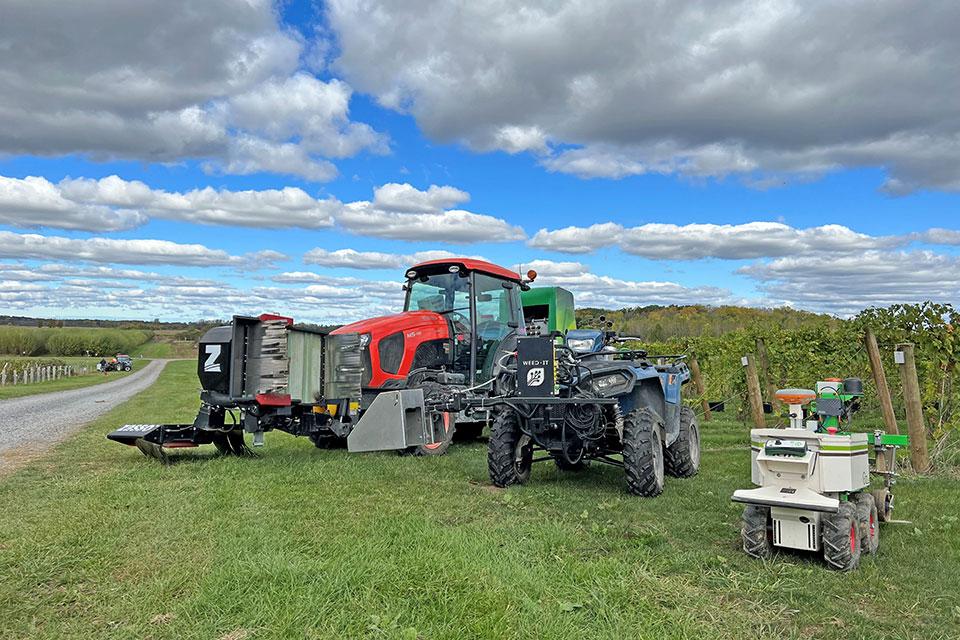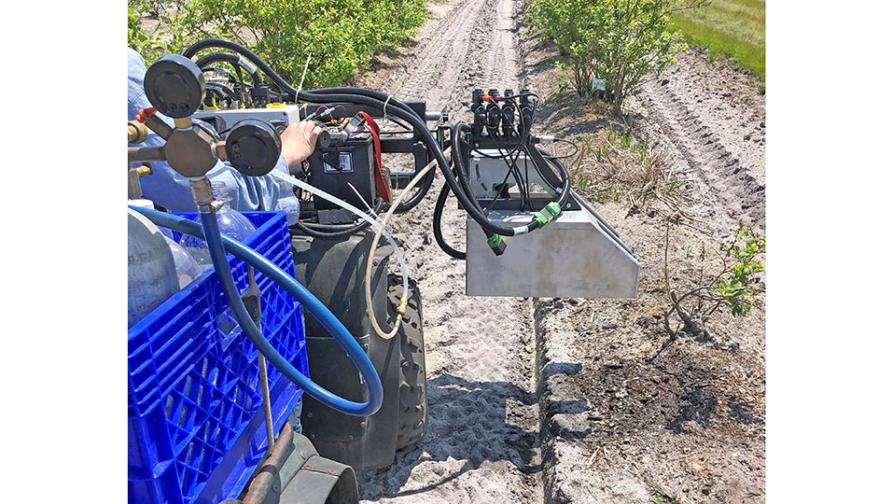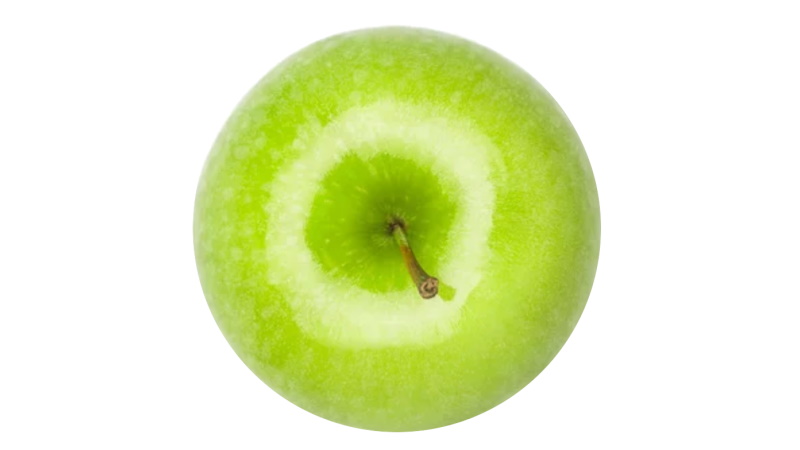On Target for a Weed Control Victory in Vineyards

Much work has been achieved regarding weed control in vineyards. Three targeted sprayers (from left): Naio Technologies “The Ted,” AgriTech America’s Weed-It Quadro, and Zasso’s Electroherb.
Photo by Lynn Sosnoskie
Grape growers are moving closer to the adoption of labor-saving robots that can reduce the number of suckers and weeds in the vineyard.
Lynn Sosnoskie, for one, could not be more excited about that progress, much of which she has verified in her own trials with Cornell AgriTech in Geneva, NY. The Assistant Professor of Weed Ecology and Management in Specialty Crops addressed vision-guided precision spray systems during an Oct. 18 webinar presented by the New York Wine and Grape Foundation.
What appeals to Sosnoskie about targeted spraying? For starters, she says, vision-guided precision spray systems can reduce both the volume of herbicide annually applied and the potential for crop injury associated with post-emergent applications. Enhanced crop safety, in turn, may allow researchers to evaluate new herbicides that could control herbicide-resistant and perennial weeds. Finally, the strategy is potentially a mitigation strategy for preventing or minimizing off-target movement that can negatively impact threatened and endangered species.
SINGLING OUT SUCKERS
Sosnoskie and her team initiated a targeted sucker control trial on May 25, 2022, at the Cornell Lake Erie Research Extension Laboratory (CLEREL) in Portland, NY. Treatment plots involved whole rows of 24 to 29 ‘Concord’ vines spaced 9 feet apart, with individual vines spread 8 feet apart within the row. Mean sucker size was 6 to 8 inches, with three unfolded leaves.
Two application strategies were compared: a vision-guided Weed-It Quadro (AgriTech America) and a backpack sprayer. Three spray treatments — Aim (carfentrazone-ethyl, FMC), Rely (glufosinate-ammonium, BASF), and tiafenacil (Gamma, Helm) — were applied at recommended rates and replicated three times for each application strategy.
“I wanted to evaluate different herbicides, both Aim and Rely, which are registered for grower use for sucker management, but I was also interested in a new active ingredient, tiafenacil, that we are testing and doing a lot of data collection to support our registration here in New York state,” Sosnoskie says. “It’s a PPO (protoporphyrinogen oxidase) inhibitor, like Aim, but it gets grasses.”
Although differences were observed with respect to sucker burndown among the herbicide treatments, the ATV-mounted Weed-It Quadro (TG-3 nozzles, 20 gallons per acre [GPA], 5 mph riding speed) and backpack sprayer (11002 nozzles, 20 GPA, 2.5 mph walking speed) performed equally well (80% to 90% control at seven days after treatment).
“The vision sprayer was just as good as the backpack sprayer,” Sosnoskie says. “We measured the sucker biomass 28 days (after application), and for both the backpack and the vision we reduced sucker biomass by an average of 80%. We burned those suckers down.”
More impressive, the Weed-It Quadro resulted in 40% less herbicide use — a figure that could have been higher, according to Sosnoskie.
“The problem was my inside sensor kept seeing the cover crop that was planted between the grape rows, and it kept trying to spray the cover crop with the inside nozzle,” she says. “I think that 40% might have been 60%, 80% or more. I need to turn that inner sensor off for sucker control.”

Cornell AgriTech’s ATV-mounted Weed-It Quadro, manufactured by AgriTech America, performed well in trials on automated weed control in vineyards. Photo by Thierry Besançon
TRIAL DETOUR
The 2022 trial resumed in 2023 but not without a hitch. The grape block at CLEREL had suffered glyphosate injury from an unrelated spray the previous fall. Necessary sucker growth never materialized the following season. After three attempts, Sosnoskie moved the trial — sans Rely — to a nearby USDA breeding block comprised of M7 apple rootstock, which is prone to suckering.
Again, Aim and tiafenacil both fared well, with no differences seen between the vision-guided and backpack applications. Better still, Sosnoskie ascertained information as to how low researchers might be able to take down the rate of tiafenacil for registration.
The Weed-It Quadro also performed well at weed control in a New Jersey blueberry trial conducted by Thierry Besançon, an Associate Extension Specialist in Weed Science at Rutgers University. Across all herbicides, there was no difference between the Weed-It sprayer and backpack sprayer.
Likewise, Team Sosnoskie achieved further success while comparing the Weed-It and backpack sprayer in a practice trial involving Rely and hundreds of horseweed plants. However, upon moving the trial into a grape system at CLEREL, the backpack sprayer did outperform the Weed-It.
“We just started off with weed densities that were way too high,” Sosnoskie says. “We were at 50% weed cover. Truly, honestly, the greater the weed density gets, the efficacy and value of vision spray systems are probably going to start going down. They’re going to start acting like a regular sprayer that is non-discriminate.”
OTHER TECHNOLOGIES
Electrical weed control (EWC) is a technology that “everyone thinks I’m crazy for doing,” Sosnoskie says, “but I’m super excited about it.” Interest in EWC has been renewed, she says, because of herbicide-resistant weeds and rising labor costs.
Cornell works with an Electroherb weeder manufactured by Zasso, a Swiss company now affiliated with AgXtend and New Holland. A tractor-mounted generator produces current, which is passed through weeds on-the-go through electrodes, destroying chlorophyll and in some cases wrecking the cell walls of the weed’s vascular system. The target species are affected immediately and desiccate within hours.
Aleah Butler-Jones, a graduate student under Sosnoskie, conducted a study comparing EWC, cultivation (Wonder Weeder/Harris Manufacturing), and EWC plus cultivation one week later. Whereas weed cover 23 days post-treatment was 80% with the untreated control, it was 35% to 40% with the Wonder Weeder, less than 25% with EWC, and 20% with EWC plus the Wonder Weeder.
“The electrical weeder caused damage to those perennial weeds and actually made it easier to go in and do the cultivation event. Some of those roots were damaged, the crowns were damaged,” Sosnoskie says. “If you’re worried about soil health, our preliminary data suggests no negative impacts on soil microbial respiration nor soil microarthropod communities. It didn’t impact the weed seedbank, either. Soil is a good insulator. We’re not seeing any damage to the crop.”
A second EWC company is England-based RootWave. Anyone interested in EWC should search for Zasso and RootWave on YouTube, Sosnoskie says.
Also of interest to Sosnoskie are the autonomous platforms that carry vision-guided weed control equipment. Naio Technologies manufactures the Ted, which is built for grape systems. Several such units are in Ontario and Quebec, she says, and Cornell is planning to add a unit by next summer, with demonstrations occurring at CLEREL and Cornell AgriTech in Geneva, NY.
“The one thing with these tool carriers that I’m really excited about is that we can probably do a lot with them besides just weed control,” Sosnoskie says. “We can put the finger weeders on it or the other cultivators on it. Can we put cameras on it for measuring crop load or phenotyping or measuring disease development and injury? Can we put banks of UV lights on these tool carriers for the management of powdery and downy mildew?”
Sosnoskie’s lab will continue to conduct trials with targeted spraying in grapes and other perennial crops in 2024 and beyond.










